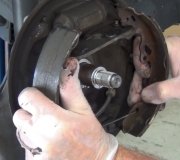Monday, January 21st, 2013 AT 12:00 AM
The break on my tempo started to go out. It an old car so I decide it my be best to replace everything just to be on the safe side. What happens is that the breaks started to lose pressure when I was stopped and I'd have to pump them back up. The master cylinder was replace. Both calipers were replaced and the drums on the back were replaced. Everything seems to be connected properly according the manual but when happens is when I go to bleed the break system I start to bleed the break system I start at the rear passenger side. Pump the breaks till there is pressure open the valve and no change. Pedal does not go to the floor like it should. Move to the drive side. Pump the breaks and hold. Open the valve. Pedal goes all the way to the ground. Front passenger side goes all the way down. Front driver side does nothing like the rear passenger side. I am at a lose as to what could be causing this. Any help would be awesome


